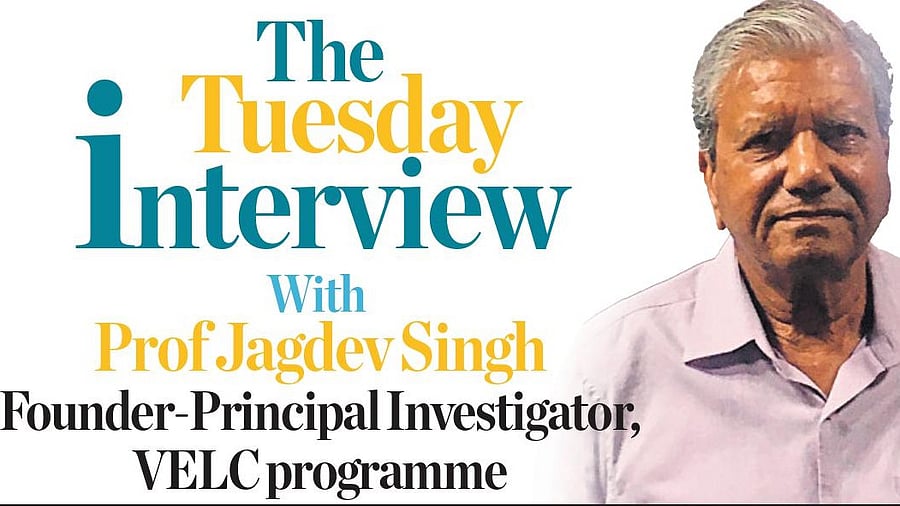
At the Indian Institute of Astrophysics (IIA) campus in Koramangala, Bengaluru, a team of scientists and engineers is setting up a facility to process data scheduled to come in from an instrument the institute developed for India’s first space-based mission to study the sun, Aditya-L1. The first batches of data from the Visible Emission Line Coronagraph (VELC), including about 1,440 images of the sun every day, are expected to reach this payload operations centre by the end of February 2024. Prof Jagdev Singh, founder-principal investigator of the VELC programme and former IIA senior scientist who is now engaged with the institute as a consultant, spoke with DH’s R Krishnakumar on how the project expanded with time, the significance of a space-based solar observatory, and what VELC sets out to explore at the sun’s outer edges.
India’s first-ever space-based solar observatory is taking off. How has the mission evolved from its original science and objectives to its present form?
It has taken about 17 years. When the idea of a space telescope was proposed, Isro offered us a smaller platform. VELC, equipped to image the solar corona (the sun’s outermost layer), was the only payload in the mission when it was conceived in 2006. The instrument was designed, and a feasibility study was done. In 2012, when we were halfway through the project, the late U R Rao (eminent space scientist and former Isro chairman) suggested that instead of observing the sun from low earth orbit, which comes with its own limitations, we should take the instrument to L1 (one of the five Lagrange points in the sun-earth system where gravitational forces from the two bodies are balanced, providing stability to the spacecraft that is placed in their line) to watch the
sun continuously.
That meant an upgrade for the instrument.
The instrument was expanded to include spectroscopic channels for the observation. Isro also added six more payloads, developed by other laboratories
and institutions, to the expanded
Aditya-L1 mission.
What necessitated the shift from earth-based facilities to a space-based mission to study the sun?
Observations from the ground are not sufficient to study the corona in detail (the extremely bright light from the sun’s surface makes this difficult). IIA also has a long history of observing total solar eclipses (to study the corona), but these observations provide data for a maximum of seven minutes, which is not enough. We needed to have an instrument in space to observe the sun all day, throughout the year.
VELC can make observations down to 1.05 times the solar radius. Is this the closest we have seen the limb of the sun?
The data from earlier missions only tells us what is happening in regions up to about 1.3 times the solar radius. This does not give us the whole picture of the corona. Additionally, the payload comes with a high cadence and can capture an image every minute.
How is VELC equipped to study Coronal Mass Ejections (CMEs)?
There is some uncertainty in our understanding of the origins of CMEs (expulsions of charged particles and magnetic fields), their acceleration from the source region, and the pace at which they reach the earth’s atmosphere. VELC has spectroscopic and imaging channels that function simultaneously, helping us determine the speed of CMEs and, in turn, accurately predict when they will reach the earth’s surface. The imaging channel also helps us understand the drivers of space weather.
Beyond the scope of VELC, how is the scientific community placed to process the data coming in from all seven payloads of the mission?
Individual teams will process the data from these payloads. Later, all the data can be studied and applied accordingly, depending on the scientific objectives. The mission is unique in that it facilitates the study of the sun in multiple ways. Take the SUIT (Solar Ultraviolet Imaging Telescope), which can image the lower and middle layers of the sun’s atmosphere, or PAPA (Plasma Analyser Package for Aditya), and the magnetometer, which can measure magnetic fields at L1. IIA and other scientific organisations can play an important role in the analysis of wide-ranging data from
these instruments.
India is following Chandrayaan-3 and Aditya-L1 up with a series of important space missions over the next couple of years. What is changing?
What is important is that India is now able to do these missions at a much faster pace. The cost involved is also substantially low when compared to similar missions undertaken by the US and European countries. These developments have given the industry a major thrust; they have generated new academic interest in space and are inspiring the young.